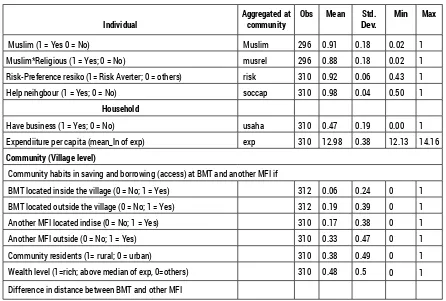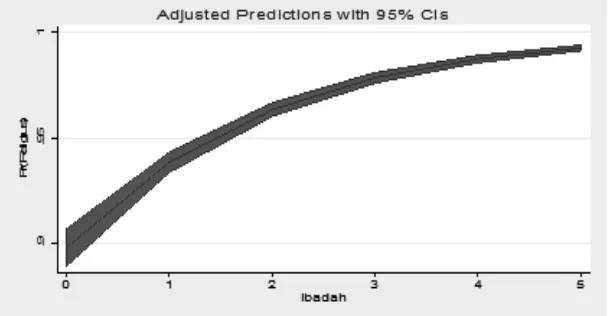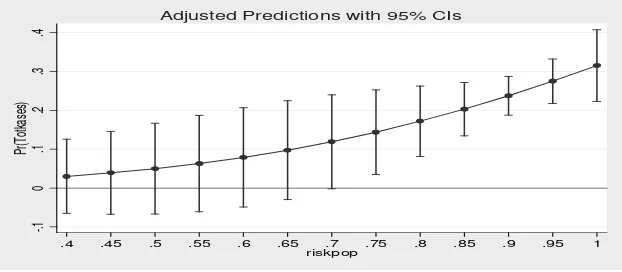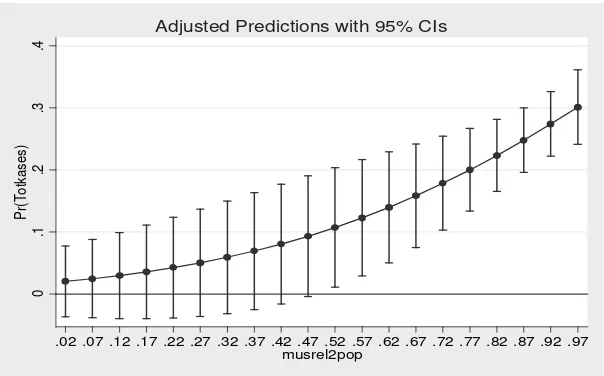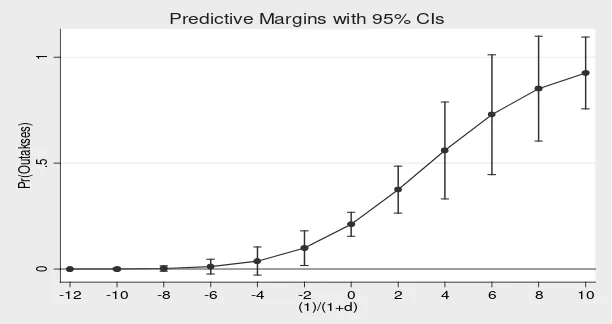ITS IMPACT ON CONSUMER’S ACCESS DECISION
DAVY HENDRI
Institut Agama Islam Negeri Imam Bonjol Padang [email protected]
Abstract
This study uses data from the survey IFLS-4 (Indonesia Family Live Surveys-wave 4) to analyze the impact of competition between lenders on client behaviour. IFLS-4 contains data on self-reported habits of community residents (312 community) decision to access to Islamic Micro Finance Institution (Islamic MFI), named Baitul Maal wat Tamwil (BMT). This data contains specific type of BMT’s location which could be accessed by community, with variously geographical distances. This data also is enriched by the presence of another type of conventional MFI. This study found that increased competition suggesting clients to change their behaviour. The presence of conventional MFI and theirs proximity as indicator of competition, very instrumental in determining access to BMT. Interesting finding, for religious type borrowers, they tend to sustain their access to BMT whose more far geographical distance, even conventional MFI presence inside their village. Thus, this study suggests that the expansion of financial inclusion strategy of Islamic MFI should also be specifically determined by behaviour of and the BMT’s location among the community.
Keywords: Micro Finance, Islamic, Competition, Borrower, Access
INTRODUCTION
Nowadays, after years of rapid microfinance market growth, poor microfinance borrowers begin experiencing repayment difficulties and defaulting on their loans. heir MFI resort to harsh and coercive methods to secure loan recovery. Chen et al. (2010) stated that the micro finance repayment crises in Pakistan, Nicaragua, Morocco and Bosnia-Herzegovina were preceded by the unprecedented growth of all emerging micro finance markets from 2004 to 2008. he latter experienced average annual asset growth of 39 percent and had accumulated total assets of over US $ 60 billion by December 2008. he growth period, however, would engender crisis in
the four concerned countries because of three core “vulnerabilities” in their respective micro finance industries: (1) concentrated market competition and multiple borrowing, (2) overstretched MFI systems and controls and (3) erosion of MFI lending discipline.
the associated phenomena of client multiple borrowing-are identified as a significant factor that tends to increase over-indebtedness. It happens when lenders, in their quest for expansion and increased market share, resort to over-aggressive marketing practices and lose discipline with regard to their internal risk management systems.
he reasons attributed to borrowers for double-dipping are to smooth the timing of repayment of loans, to maintain cash flow, and the fact that interspersing several smaller loans leads to a lower overall cost of credit given the declining-balance interest calculations prevalent in the industry. Marquez (2002) highlights the fact that competition lowers the screening ability of the incumbent bank, thus increasing the share of low quality borrowers among clients. In Petersen and Rajan (1998), competition weakens the long-term relationship between a lender and his clients, thus reducing the lender's incentives to provide insurance in response to shocks.
he repayment performance and behaviour of micro finance clients have been modelled in different ways in the micro finance literature (Fischer and Ghatak 2011, Karlan and Morduch 2013, Gonzalez 2008, Schicks 2011). Much of early theoretical work was devoted to explaining how high loan recovery rates were made possible by joint liability-an arrangement in which borrowers are grouped together and held jointly liable for each other’s repayments. As the use of individual liability loans became more common in micro finance,
one subsequent effort of theorists focused on micro finance loan contract mechanisms beyond joint liability that ensured high repayment rates, including dynamic incentives and regular repayment schedules. In time, theory also began to model the incentive effects of micro finance market competition and multiple borrowing as well as the problem of over-indebtedness of borrowers.
In this paper, we exploit the increasingly intense interactions between MFIs in Indonesia both Islamic and conventional using IFLS-4 data in 2007 to analyze how borrowers at community level respond to competition between different kinds of lenders. We begin by reviewing the major theoretical predictions found in the literature and, on that basis, develop our hypotheses explaining client behaviour that can be taken to the data. We perform two different but related analyses. First, we examine the determinants of borrowers access type decisions to BMT, and so that gain an understanding of the market segments occupied by different kinds of borrowers. Second, we look at the differential effect of competition from various attribute of lenders such as their presence and proximity on individual clients with specific characteristics.
variable and some other control variables in both level of individuals, households and communities such as risk preferences, business ownership status (non-farm), the average expenditure per ca pita and social capital. Part 3 is an empirical analysis, which aims to assess whether the distance BMT-community and religiosity status, significantly affect access to BMT. Finally, Section 4 discusses some policy implications to expand and maintain the sustainability of BMT.
Pre vio us Study
Although papers rarely directly address the effect of increased competition in absence of information sharing on repayment rates, it can indirectly be inferred in some cases. Besley and Coate (1995) showed how joint liability can help lenders in markets without observable lending histories overcome information problems, but also that such contracts remain vulnerable to strategic behaviour by the entire lending group. he implication is that increased competition could lead to a higher incidence of group default. Marquez (2002) highlighted the fact that competition lowers the screening ability of the incumbent bank, thus increasing the share of low quality borrowers among clients. In Petersen and Rajan (1998), competition weakens the long-term relationship between a lender and his clients, thus reducing the lender's incentives to provide insurance in response to shocks. Both circumstances would lead to lower repayment rates. Most pertinent is a paper by Hoff and Stiglitz (1998) which examines the role that multiple uncollateralized lenders will play in
reducing each other's abilities to use dynamic incentives effectively.
he important for incumbent micro-lenders is also to know which types of individuals are most likely to be drawn away from them by competition. Conning (1999) and Navajas, Conning, and Gonzales-Vega (2002) presented models in which differential abilities at collateral collection, screening, and monitoring lead different types of lending institutions to focus on different client bases. According to this theory, considering that our data consist solely of current clients in a village-banking institution, we would expect to see the 'best' clients being drawn away by lenders who invest more in screening and offer better terms. Additionally, considering that the pre-eminent role of collateral in mitigating moral hazard in lending, clients who depart for higher-level lenders should be those that posse the used assets to those lenders as collateral and as screening tools.
the guidelines of religion) is an important indicator of potential borrowers who are considered to be a proxy for social collateral (replaces physical collateral) as well as reduce the potential for moral hazard of potential borrowers (Berggren, 2014). According to this context, we hypothesized that the more religious consumer will not shifting (reduce) their access (probability) to Islamic MFI.
his study is interesting because previous studies that discuss competition between microfinance institutions of Islam MFI vs. Conventional MFI are still rare. Many studies analyze competition between these two institutions, but still limited at banking industry level, not at MFI one. Besides that, the study also focuses on the comparative aspects of the performance of financial institutions side such as the impact of competition on profit. here are still rarely discussing its impact on the borrower side. If anything, the comparison of the borrower is limited to their socio-economic characteristics as a client on these two institutions. here fore, this study tries to fill the void of the study.
METHODOLOGY
To investigate this hypothesis, this study is designed as take advantage of the availability of data on the type of access to BMT questionnaire of Indonesia Family Live Survey (IFLS) wave 4.
Da ta
he main data set for analysis is the Indonesian Family Life Survey (IFLS), socio-economic household survey based on
a sample representing 83% of Indonesia's population includes 29 060 adults in 12.688 households living in 312 communities at 13 of Indonesia’s provinces. In the book community characteristics and facilities (book 1 section G) provide the question about people's habits in saving/ borrowing in BMT whose location is divided into two, namely inside the community residents (in-access) and outside the community residents (out-access).
Meanwhile, in the books of individual and household characteristics are also available the question of religion and the status of individual religiosity in every community (book section 3A TR). herefore, the status of access is only available at the community level, then the characteristic determinant on an individual level as religiosity, risk preferences, social capital and the level of household characteristics such as the ownership of the business, with the exception of expenditure per ca pita, aggregated into the community level.
Table 1. Individual and Household Characteristics Aggregated at Community Level
Individual
Aggregated at community
Obs Mean Std. Dev.
Min Max
Muslim (1 = Yes 0 = No) Muslim 296 0.91 0.18 0.02 1
Muslim*Religious (1 = Yes; 0 = No) musrel 296 0.88 0.18 0.02 1
Risk-Preference resiko (1= Risk Averter; 0 = others) risk 310 0.92 0.06 0.43 1
Help neihgbour (1 = Yes; 0 = No) soccap 310 0.98 0.04 0.50 1
Household
Have business (1 = Yes; 0 = No) usaha 310 0.47 0.19 0.00 1
Expendiiture per capita (mean_ln of exp) exp 310 12.98 0.38 12.13 14.16
Community (Village level)
Community habits in saving and borrowing (access) at BMT and another MFI if
BMT located inside the village (0 = No; 1 = Yes) 312 0.06 0.24 0 1
BMT located outside the village (0 = No; 1 = Yes) 312 0.19 0.39 0 1
Another MFI located indise (0 = No; 1 = Yes) 310 0.17 0.38 0 1
Another MFI outside (0 = No; 1 = Yes) 310 0.33 0.47 0 1
Community residents (1= rural; 0 = urban) 310 0.38 0.49 0 1
Wealth level (1=rich; above median of exp, 0=others) 310 0.48 0.5 0 1
Difference in distance between BMT and other MFI
Va ria b le a nd Me a sure m e nt
his section will try to describe the process to generate multiple dependent variables and controls used in the analysis.
Risk Pre fe re nc e s
To measure the level of risk aversion, it is used questions related to personal financial risk in the data characteristics of individual/ household book section 3A SI. Two questions that are analyzed risk preferences are questions SI21 and SI22. If the selection of respondents performance SI21 question are C and tested through cross- checking the consistency of the answers of the questions SI22. If the respondent is then also answered C on questions he regarded having SI22 preference avoid the risk (risk-averse). A value of 1 is the code for the response to avoid the risk, and
the values of 1 encoded for the other (multiply risk-lover and risk-neutral).
Muslim Re lig io sity
interacted. In accordance with the objectives of this study, the variation religiosity of Muslim respondents only would be the main repressors. Question of religiosity in IFLS-4 is a question of self-assessment. It is therefore necessary to examine how the answers to these questions relate to the observed behaviour. For adherents of each religion, IFLS-4 is asked for a pair of questions about a person's religious
practices. Muslim TR13 are asked to answer questions about how many times they pray (shalat) every day and whether they observe kosher dietary needs. A study in the different themes but in the context and the same variable (Gaduh, 2012) uses this data to validate the self-assessment of respondents religiosity. he following table analyzes used in his study
Table 2. Distribution of Worship Practice Muslim Respondents by Level of Religiosity
Not religious Somewhat religious Religious Very religious Refused to answer
Do not Practice 0.66 0.25 0.04 0.01 0.19
Between 0 and 5 0.23 0.43 0.11 0.09 0.07
5 times 0.03 0.29 0.73 0.63 0.47
More than 5 0.01 0.02 0.11 0.23 0.07
Refused to answer 0.00 0.00 0.00 0.00 0.21
Sumber : Gaduh (2012)
Table 2 shows the pattern of a strong correlation between a person's self-assessment of religiosity and adherence religious practices. For Muslim respondents, the more religious he assesses himself, the more likely that he follows (and beyond) the amount of obligatory prayers five times a day. Slightly different and for the
purpose of simplification of analysis, then in this context, then the answer options 1, 2 and 3 are categorized as religious and encoded with 1, while 0 for other answers. he scale is then obtained additional information that each additional 1 (one) unit of worship will increase the probability of respondents to be religious.
MFI c o m pe titio n m e a sure s
hroughout this analysis, we use three measures of competition defined as follows: • Presence, indicating whether there is any
MFI competitor in/outside village.
• Proximity of the closest competitor, if there is any, measured by proximity
= 1 1 + d
In which d = difference in distance between BMT with another MFI from the village centre (distance of BMT- mean distance of MFI), according to two types of location (inside and outside the village). hus the proxy value is in the range -> 1> +. he more positive the value of proximity, closer others MFI to BMT, to be accessed by the community.
Estim a tio n Stra te g y
Ordinary Probit
To estimate the possibility of community access to the BMT (1 if yes and 0 if not), linear probability model (probit regression) is used. In the linear probability function, the dependent variable is a binary variable that takes the value of zero or one. For the record, there are two models that will be tested here. Both models that have the same dependent variable are the variable interest (primary); religiosity and various other control variables at the individual and household level which is already aggregated into the community level. he model is as follows:
v iv hv v v
A
X H
G
he variable Xiv is the vector of
aggregate characteristics of individuals in the community. While Hhv is the vector of
aggregate characteristics of households in the community. While Gv is the vector of variables
at the level of the community itself.
To estimate the competition (with other MFIs) to community probability access to the BMT, we should use 2-SLS probability model (iv probit regression). he estimation of the presence of other MFIs (as a competition indicator) should calculate it’s rational decision to presence inside community residence. Several reason must be accommodated. At least the MFIs will presence in specific place because there are another MFIs has already presence in another place. herefore in this context we instrumented the MFIs inside community-type of presence with the MFI outside community-type of presence.
RESULTS AND DISCUSSION
his section presents the results of a description of the data and the estimates of the analysis with an econometric model in the previous section.
-.1
0
.1
.2
.3
.4
Pr(T
ot
ka
se
s)
.4 5.4 10.4 15.4 20.4 25.4 30.4 35.4 40.4 45.4 jarak
Predictive Margins with 95% CIs
Figure 2. Margin Map-- Distance and Access Probability
Several studies suggest that distance is an important factor that weakens people’s financial access in some countries (Seep Network, 2006), including in the United States (Petersen and Rajan, 2002). When considering a transaction between two agents in the case of households, and individuals or groups of individuals and microfinance institutions, the effect of distance is translated into physical costs that must be paid by agents to be able to realize the transaction. Some literatures describe the transmission mechanism of distance to access to the credit markets both in terms of producers and consumers in several ways. From the micro finance institutions as a producer, first, there is a direct transaction costs, ie the cost of transport to provide financial services to the borrowers.
In a competitive financial market, the cost is borne by the borrower in the form of more intense screening and higher interest rates. he second implication is the increase in the cost of monitoring: if the lender needs to gather information prior to approval of the borrower (adverse selection), or monitor the borrower after the loan is approved (moral hazard), it is performed during a visit to monitor. his in turn means tighter lending restrictions and the imposition of higher interest rates. Meanwhile, from the borrower as a consumer, opportunistic behaviour - i.e. choosing consumption rather than investment - tend to more easily unfold the greater the distance from microfinance institutions, because of the possibility of a lower detected (Presbitero, 2011).
-.1
0
.1
.2
.3
.4
Pr(T
ot
ka
se
s)
.4 .45 .5 .55 .6 .65 .7 .75 .8 .85 .9 .95 1 riskpop
Adjusted Predictions with 95% CIs
0
.1
.2
.3
.4
Pr(T
o
tka
se
s)
.02 .07 .12 .17 .22 .27 .32 .37 .42 .47 .52 .57 .62 .67 .72 .77 .82 .87 .92 .97 musrel2pop
Adjusted Predictions with 95% CIs
Figure 4. Margin Map-- Religiosity and Access Probability
While the status of risk preference turns to determine access to the BMT, in a positive direction although not significant. he greater proportion of type risk-averse individual in a community then they are more likely to choose the access to BMT located within the community. Another interesting result in figure 3 above showed that, the status of religiosity turns out determine access to the BMT in a positive direction significantly. he more religious a Muslim community, the larger their probability of access to BMT.
Follow-up question is; does the pattern of this relationship apply to all conditions? Is there another explanation for this condition? herefore, this fact needs to be tested by analysis of the influence of the control variables. Table 4 shows the probit regression with some additional control variables. Processed results of probit regression with several control variables explain at least two things. First, answer the questions on the discussion of the previous 3.1. It turns out from the side of BMT access status in the community at all of the
model; namely models 3,4, and 5. he status of religiosity (Muslim religious) is enough to explain the pattern of relationships. Second, household characteristics contribute to better determine the status of community access to the BMT located at their communities.
On the other hand, this could indicate that the Muslims of various strata and status have access to BMT. Meanwhile, it turns out a different control variables, namely preferences towards risk, also turned out to be a defining aspect of the determinants of access. Probit regression processed shown in Table 4 shows that individual turned out to be Muslims as a whole, whether religious or not, it is better to avoid the risk (risk-averter). his is consistent with the concept that underlies the practice of Shariah financial institutions in general, i.e. transactions for definite purposes, not speculation.
others. Although activity does not specifically mention the type of activity of lending and borrowing money, but the findings are at least in line with the statement of some other studies. Research conducted that BMT presence as a source of funding has reduced the intensity of other informal financial loans in a community.
Probit regression models (3), (4) and (5) in table 3 are several model that already incorporate variable; location of a community, rural or urban area. he estimation results indicate that in fact the relation of religiosity and risk preferences variables with the type of access to the BMT unchanged, including the level of its significance. In addition, estimated result also indicates that communities location’s relations (in urban areas) with various types of access to BMT is a negative one although not significant. At the same time also shows that in fact the BMT just distributing rather evenly in urban areas.
Furthermore, those probit regression models above already incorporate variable; community prosperity level, which is measured by the threshold of communities median expenditure. he estimation results indicate that in fact the level of prosperity of a community relations with various types of access to BMT is a positive one, although not significantly. It also shows that in fact the new BMT distributing rather evenly in the community (samples) are relatively better off than average total population.
C o m pe titio n With O the rs MFI
his section presents the analysis of BMT competition with other LK and its impact on the probability of access to BMT. Discussion of this aspects includes two parts, on the impact of the presence and the proximity of other MFIs.
Pre se nc e o f o the rs MFI
Processed regression shows that the presence of other MFIs inside the community residence reduces probability access to BMT significantly, in accordance to the hypothesis. McIntosh and Wydick (2005), in their theoretical paper on competition and microfinance showed that competition may prove detrimental to some or all of the borrowers in a microfinance market. In its initial monopolistic stage there are rents to be made for the lender and it is profitable to serve both the more and less profitable participants due to cross subsidies. Once competition sets in however, prices will be pushed down due to Bertrand competition and client-maximizing behaviour, thus rents will be eliminated.
along their profitability and time preference characteristics, the poorest are neglected first and the least patient borrowers are worst
off, as they slip into "double dipping" or "overlapping" - which means taking out multiple loans.
0
.5
1
Pr(O
ut
akse
s)
-12 -10 -8 -6 -4 -2 0 2 4 6 8 10 (1)/(1+d)
Predictive Margins with 95% CIs
Figure 5. Margin Map-- Proximity and Outside Access Probability
Pro xim ity with o the rs MFI
It turns out the resultant of (net) impact of the presence of other MFIs is also ambiguous on the probability of access to BMT. On one condition, the existence of other MFIs plays as substitute role for BMT. However the processed regression shows that the proximity between BMT with other MFIs which located inside the community residence increase probability access to BMT significantly, in accordance to the hypothesis. Figure 5 above shows that the probability of access to BMT grows significantly as long as it’s proximity increasing.
here are monotone changes from a negative value (BMT are further away than MFIs) to positive (MFIs are further away than BMT) as an increase in the probability access. Every (about) 2 km distance reduced between these two MFIs location will increase the probability of access to BMT by 10%. hus if BMT (even only 1) is located inside
the community, this institution still remains an option for Muslim respondents who are relatively more religious.
CONCLUSION
Linear probability estimation in the analysis section shows several important conclusions. First, individuals who are more religious Muslims have a greater probability for access to BMT. he conclusion of this study is in accordance with the existing hypotheses and findings from previous studies. Probit regression estimation results are displayed on a variety of estimation model above shows other interesting findings. It turns out the existence of other MFI reduces the probability access to BMT.
there is an external shock. It is inexplicable that in a model with access to BMT in the community, consumer risk preferences (risk-averse) are positively related to it.
he important for incumbent micro-lenders is also to know which types of individuals are most likely to be drawn away from them by competition. Differential abilities at collateral collection, screening, and monitoring lead different types of lending institutions to focus on different client bases. According to this theory, considering that our data consist solely of current clients in a village-banking institution, we would expect to see the 'best' clients being drawn away by lenders who invest more in screening and offer better terms. Additionally, considering the pre-eminent role of collateral in mitigating moral hazard in lending, clients who depart for higher-level lenders should be those that posse the used assets to those lenders as collateral and as screening tools.
In the end, the common thread that can be drawn from here is the distance that is very important to determine the probability access to BMT. In the context of this study, which assumed a limited number of BMT per community (only 1) and consider the availability of other MFIs, then the distance as a means of natural selection for consumer access decision the BMT. herefore, as a consequence for the BMT, this could be a reference to determine the mechanism of different services for consumers with different types.
Future strategies to expand BMT outreach should consider that moral hazard
is a critical issue and that physical proximity could contribute to attenuate it. However, subsequent analysis are necessary to deepen the role of distance in microcredit along several lines, in order to draw more sensible policy guidance. The first one would focus on alternative settings and especially on rural ones, in which low population density and poor transportation can make distance a more binding constraint. A further extension of this kind of analysis might focus on the role of distance on repayment rates and on margin rates applied by the BMT.
Re se a rc h Lim ita tio ns
Some obvious limitations to this study, especially on the issue of the quality and limitations of the data. Data available for the dependent variable are data at the macro level, the community. While the majority of independent variables such as individual and household characteristics are data on the micro level. hus the estimation can be done then the aggregation of data from the micro to the macro level has many weaknesses, namely a selection of risks to be taken. In addition, data IFLS module is only available in IFLS-4, which means the estimation process can only be done by cross-section includes only 312 observations.
sample is already limited, this test produces a small statistical power and meaning.
hird, some scale-forming measurement variables. herefore variables used here are socio-cultural variables, then the accuracy of the concept and selection of key measurement indicators become important in the estimation process. Improper selection of indicators will affect the measurement and estimation bias the results. Moreover, as the plural of research with the use of qualitative variables such as socio-cultural, then the endogeneity problem becomes one source of vulnerability (non-robust) the main results of the estimation.
REFERENCES
Albelaikhi, Abdulaziz. Development of a Muslim Religiosity Scale, University of Rhode Island, 1998.
Al-Sabwah, Mohammed and Ahmed Abdel-Khalek. Religiosity and Death Distress in Arabic College Students. Death Studies,
30 (4) : 365-375, 2006.
Ashta, Arvind and Rosita de Selva. Religious Practice and Microcredit: Literature Review and Research Direction, Postmodern Openings, 2 (8) : 33-44, 2012.
Besley, T., and Coate, S. Group Lending. Repayment Incentives and Social Collateral.
Journal of Development Economics, 46 : 1-18, 1995.
Chamberlain, G. Analysis of Covariance with Qualitative Data, The Review of Economic Studies, 47 (1) : 225-238, 1980.
Conning, J. Outreach, Sustainability and Leverage in Monitored and Peer-Monitored Lending. Journal of Development Economics, 60 : 51-77, 1999.
Cressy, Robert. Credit Rationing or Entrepreneurial Risk Aversion? An Alternative Explanation for the Evans and Jovanovic Finding. Economic Letters,
66 (2) : 235-240, 2000.
De Meza, David, and David Webb. Risk, Adverse Selection and Capital Market Failure, The Economic Journal, 100 (399): 206-214, 1990.
Greenwood, J., and Jovanovic, B. Financial Development, Growth and the Distribution of Income, Journal of Political Economy, 98 (5) : 1076-1107, 1990.
Dusuki, Asyraf. Banking for the poor : the role of Islamic banking in microfinance initiatives, Humanomics, 24 (1), 49-66, 2008.
Dutta, Dilip and Ihab Magableh. A socio-economic study of the borrowing process: he case of micro entrepreneurs in Jordan.
The University of Sydney School of Economics and Political Science, 1-20, 2006.
Ghorbani, Nima, P. J. Watson, Ahad Ghramaleki, R. J. Morris, and Ralph Hood, Muslim Attitudes Towards Religion Scale: Factors, validity, and complexity of relationships with mental health in Iran.
Hoff, K., and Stiglitz, J. Money Lenders and Bankers : Price- Increasing Subsidies in a Monopolistically Competitive Market.
Journal of Development Economics, 55 : 485-518, 1998.
Islam, Asadul, Chau Nguyen and Russell Smyth. Does microfinance change informal lending in village economies? Evidence from Bangladesh, Department of Economics Discussion Paper No. 16/14, Monash University, 2014.
Jana-Masri, Asma and Paul Preister. he development and validation of a Qur'an-based instrument to assess Islamic religiosity: he Religiosity of Islam Scale.
Journal of Muslim Mental Health, 2 (2) : 177-188, 2007.
King, R., and Levine, R. Finance, Entrepreneurship and Growth: heory and Evidence. Journal of Monetary Economics, 32 (3) : 513-542, 1993.
Kletzer, K. Asymmetries of Information and LDC Borrowing with Sovereign Risk.
THE ECONOMIC JOURNAL, 94 (374) 287-307, 1984.
Marquez, R. Competition, Asymmetric Information, and Information Dispersion in the Banking Industry. Review of Financial Studies, 15 (3) 901-926, 2002.
Navajas, S., Conning, J., and Gonzales-Vega, C. Lending Technologies, Competition, and Consolidation in the Market for Microfinance in Bolivia, Journal of International Development,
15 : 747-770, 2003.
Pagano, M. Financial Markets and Growth: An Overview. European Economic Review, 37 (2) : 613- 622, 1993.
Petersen, M., and Rajan, R. he Effect of Credit Market Competition on Lending Relationships. The Quarterly Journal of Economics, 110 (2) : 407-443, 1995.
Pearlman, Sarah. Too Vulnerable for Microfinance? Risk and Vulnerability a Determinants of Microfinance Selection in Lima. Journal of Development Studies,
48 (9) : 1342-1359, 2012.
Saeed, Asif and Lutfullah Saqib. Does Microfinance molded according to Islamic Finance? Evidence from Pakistan,
Interdisciplinary Journal of Contemporary Research in Business, 3(3) : 826-836, 2011.
Stiglitz Joseph and Andrew Weiss. Credit Rationing in Markets with Imperfect Information. The American Economic Review, 71 (3) : 393-410, 1981.
Stiglitz, Joseph. Peer Monitoring and Credit Markets," The World Bank Economic Review, 4 (3) : 351-366, 1990.
